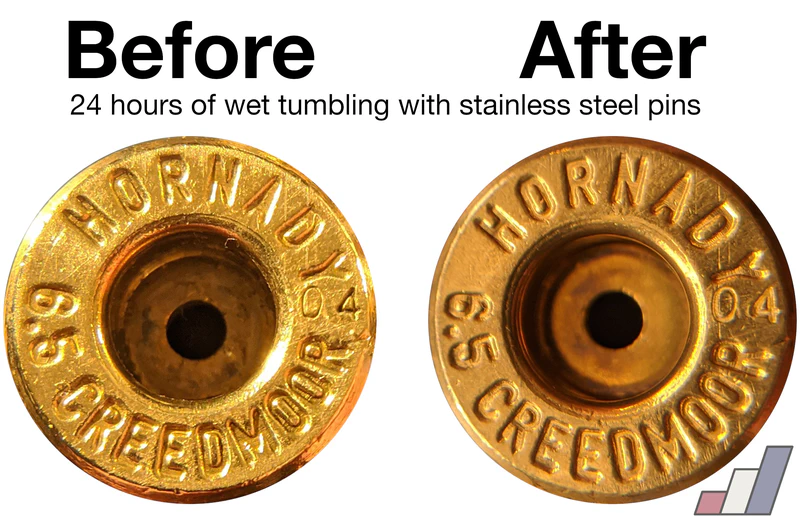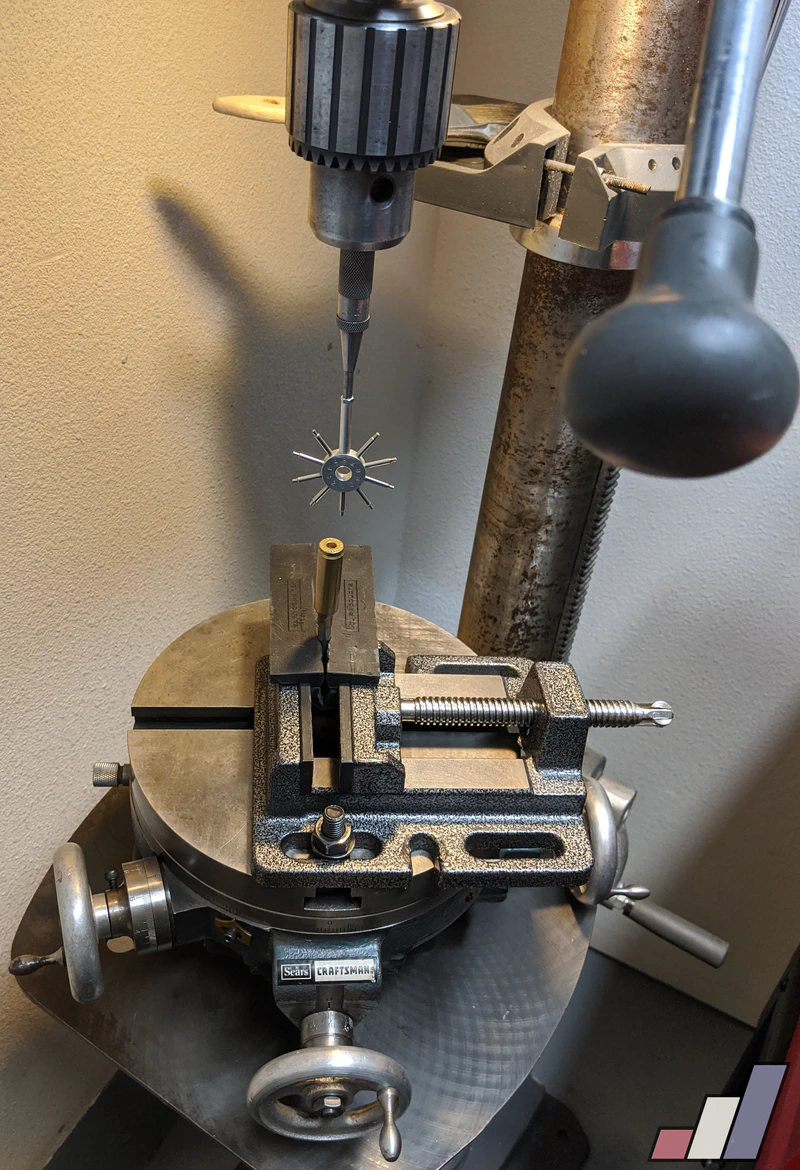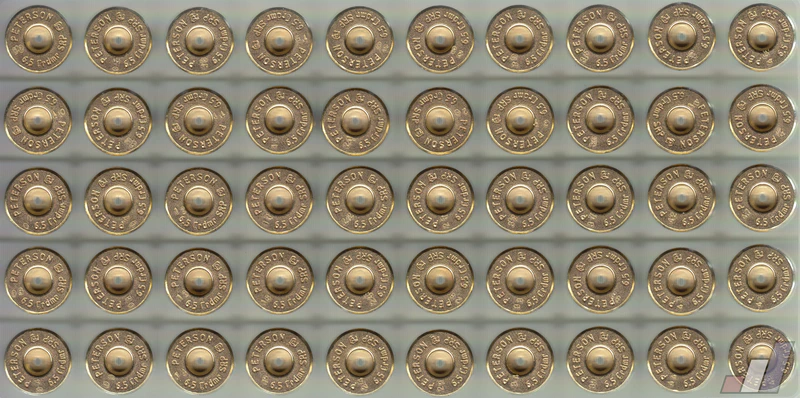Rifle Brass Sorting Experiment - Part Two
Microstamping Your Rifle Brass for Next-Level Load Development
In the first part of this series, I spent a significant amount of time and energy measuring several dimensions of the same rifle cases, over and over for five firings. The goal was simple – to measure the relationship between the weight and volume of the cases. The theory-first approach I took does have its merits, but admittedly the results were a bit less clear.
Another valid way to approach this experiment is results-focused. To simply record the performance (muzzle velocity, score, etc) of each case, look for outliers, then try to better understand why they are outliers.
The same obstacle that prevents either method from being practical. Namely, a reliable way to keep track each and every rifle casing throughout several rounds of firing, cleaning, and reloading. My solution to this problem? Microstamping.
As usual, the raw datasets are available on GitHub.

Microstamped precision rifle cases
Overview
The charts in my previous article about sorting rifle brass, which showed how the dimensions of each case changed over the course of several firings, gained a lot of attention from readers. Besides being time-consuming, the biggest challenge was simply maintaining the order of each case. When I finally trimmed the cases to length after the third firing, I realized that I had finally messed them up. While my mistake didn't ruin the experiment, I would need to solve that problem going forward.
What I wanted was a way to permanently mark each case with a number. Sharpie markers and paint pens won't withstand the cleaning process of wet tumbling with stainless steel pins. Finally, it dawned on me – microstamps! Sure enough, I found a company in California that manufactures a reasonably-priced jewelers microstamp made from hardened steel for marking 1mm tall numerals, perfect for stamping brass.
I couldn't find anyone who has used this technique before, which tells me that we're breaking new ground. Interestingly, the top search results for microstamping do relate to firearms, but as they pertain to laws and restrictions in states like California. Having lived there for a decade, I'm very familiar with those issues – this article isn't about that and I'm not here to discuss politics.
Why Bother Microstamping Brass?
The goal of microstamping your brass isn't to let you easily identify your brass from someone else's. The goal is to aid your load development and give you a competitive edge with the next level of insight into how your ammunition performs.
How, you ask? Microstamping your brass eliminates a variable from your load development that you may not have considered. If you can't correlate your velocity data to each individual piece of brass then you're randomizing the only reusable component during your tests.
Consider if you were to sort your rifle brass by weight (lightest to heaviest), volume (least to most capacity), or just beauty (prettiest to ugliest). Now, if you were to stamp those cases, you can be certain which ones you're using in your load testing or matches. You can always fire them in the same order that they were sorted, or some other order that suits your needs. You can track the velocity, chamber pressure, or performance of each case is over their lifespan. The list goes on.
Pros & Cons of Microstamping
Right off the bat I'll tell you that if you're the kind of person who prefers the extra-large gauges in your Buick or writing in ALL CAPS because it's easier on your eyes – this technique isn't for you. I'm 40 years old, colorblind, nearsighted, and am still personally able to read these 1mm microstamps. The manufacturer is kind enough to include a loupe, which makes it even easier, as does a well-lit room. The point is that they can be difficult to read for some folks and I'd rather not get a bunch of angry emails from disgruntled readers, especially in ALL CAPS.
That said, here are a few quick pros/cons of microstamping.
Pros:
- Maintains case order, with or without sorting
- Survives wet/stainless tumbling
- Gained insight into individual case performance
Cons:
- Stamping process is time consuming
- Stamps can be difficult to read for some people
- The stamping tool may be considered too expensive by some
24 Hours of Lemi Shine
Before I stamped hundreds of cases, I wanted to be certain that this tool would mark deep enough to still be readable after several sessions of wet tumbling with stainless steel pins. To simulate that, I tumbled a few test cases for 24 hours straight. I usually tumble cases for about 2 hours, so this is equivalent to 12 reloads on each case which may be beyond their actual useful lifespan. Below are some before & after photos of those cases in which you can clearly see that the stamps held up beautifully.

Hornady 6.5mm Creedmoor case microstamped with 04, before and after 24 hours of wet tumbling with stainless steel media.

Lake City .223 Remington case microstamped with 5 and 7, before and after 24 hours of wet tumbling with stainless steel media.
Want to see more articles like this?
The generosity of our supporters keeps this site ad-free. It also affords me the components, equipment, and time needed to conduct these experiments and produce great content for everyone.
Check out my Patreon page to learn more about the benefits of supporting Ammolytics. Your support keeps Ammolytics going!
How I Stamped 250 Cases
Since I operate Ammolytics in my spare time on a shoestring budget, I convinced a fellow competitive marksman to purchase one for himself and he was kind enough to loan it to me. (Thanks, David!) I tried marking different parts of the case on both 6.5mm Creedmoor and .233 Remington cases and finally decided that marking the bottom of the case was the best option for a few reasons:
- The manufacture stamp was already there, so there was little risk of compromising the case
- Easier to hold it in place for stamping
- There's usually enough empty space to add two digits
- It'd be easy to sort the cases when they were placed upside down on a reloading tray or in the box
Then it was time to stamp the cases that I'd be experimenting with, 250 cases in total.
- 50 used Peterson cases
- 100 new Peterson cases
- 100 new Lapua
This was far too many to mess around with hand tools and hammers, so I rigged up an automatic punch adapter, then I built a simple jig with my drill press. A gauge pin in a vise would position each case and the automatic pinch was held in the drill press chuck. The operation would be fairly straightforward – drop a case onto the pin, set the correct stamp number, and pull down the drill press handle to stamp the brass.

Microstamping tool with a shop-built adapter for an automatic punch.

Drill press microstamping jig. Not very skookum.
It wasn't perfect.
- The pin I used was an intentionally sloppy fit so that I could have some wiggle room for correcting the stamp placement.
- The automatic punch didn't fit very well into the chuck which meant the automatic spring mechanism started to get finicky.
- At one point, I was just using pressure to stamp the brass instead of the punch's hammering mechanism.
Regardless, it was much faster and less error prone than stamping by hand and I got through them all.
The case heads were indexed and marked 00 through 99. You can see the results in the following photo, which I took using a flatbed scanner.

50 microstamped case heads of Peterson 6.5mm Creedmoor brass.
As an aside, I've been experimenting with a flatbed scanner as an optical comparator. The idea is to quickly and easily measure case mouth diameter, concentricity, and neck thickness using image analysis & quantification software instead of calipers and micrometers. It's a heck of a lot faster, since you could can scan 100 cases or more at once and let the software do the work for you. More on that in a future article – I'm still working on it. Have I mentioned that you can support my work through Patreon?
Per-Case Performance Metrics
Since stamping the original batch of 6.5mm Creedmoor cases I've only fired them twice, each time using my standard load, a MagnetoSpeed V3, and a ShotMarker target at 600 yards. The following charts provide interesting observations, even if it's not much data to draw any conclusions.
The two days on which I fired these rounds were three months and 24°F apart, which may account for the faster average muzzle velocity.
Note: Case 42 was damaged and is omitted from the dataset.
Muzzle Velocity Comparison
There's other data to consider which is not captured by these charts, such as the amount of time the barrel was allowed to cool between each shot and each string. As I've observed in other experiments, the velocity tends to increase as the barrel heats up.
 interactive_space Open Interactive Chart
interactive_space Open Interactive Chart
Target Velocity Comparison
 interactive_space Open Interactive Chart
interactive_space Open Interactive Chart
Note: The maker of the ShotMarker target does not publish any details about the accuracy or precision of the velocity data it reports, so these values should not be given too much weight.
Per-Case Muzzle and Target Velocity Table
| 2020-02-15 | 2020-05-17 | Mean | Delta | |||||
|---|---|---|---|---|---|---|---|---|
| Case | Muzzle (ft/s) | Target (ft/s) | Muzzle (ft/s) | Target (ft/s) | Muzzle (ft/s) | Target (ft/s) | Muzzle (ft/s) | Target (ft/s) |
| 1 | 2732 | 1912 | 2756 | 1927 | 2744.0 | 1919.5 | 24 | 15 |
| 2 | 2735 | 1872 | 2772 | 1946 | 2753.5 | 1909.0 | 37 | 74 |
| 3 | 2727 | 1893 | 2767 | 1959 | 2747.0 | 1926.0 | 40 | 66 |
| 4 | 2739 | 1908 | 2758 | 1928 | 2748.5 | 1918.0 | 19 | 20 |
| 5 | 2730 | 1904 | 2764 | 1951 | 2747.0 | 1927.5 | 34 | 47 |
| 6 | 2726 | 1882 | 2758 | 1941 | 2742.0 | 1911.5 | 32 | 59 |
| 7 | 2733 | 1916 | 2777 | 1950 | 2755.0 | 1933.0 | 44 | 34 |
| 8 | 2742 | 1886 | 2777 | 1957 | 2759.5 | 1921.5 | 35 | 71 |
| 9 | 2746 | 1892 | 2778 | 1964 | 2762.0 | 1928.0 | 32 | 72 |
| 10 | 2741 | 1891 | 2776 | 1967 | 2758.5 | 1929.0 | 35 | 76 |
| 11 | 2749 | 1910 | 2771 | 1949 | 2760.0 | 1929.5 | 22 | 39 |
| 12 | 2741 | 1905 | 2781 | 1951 | 2761.0 | 1928.0 | 40 | 46 |
| 13 | 2738 | 1883 | 2770 | 1965 | 2754.0 | 1924.0 | 32 | 82 |
| 14 | 2744 | 1904 | 2765 | 1948 | 2754.5 | 1926.0 | 21 | 44 |
| 15 | 2743 | 1906 | 2765 | 1955 | 2754.0 | 1930.5 | 22 | 49 |
| 16 | 2732 | 1918 | 2757 | 1922 | 2744.5 | 1920.0 | 25 | 4 |
| 17 | 2737 | 1887 | 2777 | 1944 | 2757.0 | 1915.5 | 40 | 57 |
| 18 | 2727 | 1877 | 2770 | 1929 | 2748.5 | 1903.0 | 43 | 52 |
| 19 | 2735 | 1899 | 2770 | 1937 | 2752.5 | 1918.0 | 35 | 38 |
| 20 | 2724 | 1893 | 2772 | 1962 | 2748.0 | 1927.5 | 48 | 69 |
| 21 | 2737 | 1906 | 2768 | 1958 | 2752.5 | 1932.0 | 31 | 52 |
| 22 | 2733 | 1881 | 2776 | 1952 | 2754.5 | 1916.5 | 43 | 71 |
| 23 | 2757 | 1898 | 2774 | 1942 | 2765.5 | 1920.0 | 17 | 44 |
| 24 | 2740 | 1918 | 2763 | 1932 | 2751.5 | 1925.0 | 23 | 14 |
| 25 | 2745 | 1912 | 2784 | 1952 | 2764.5 | 1932.0 | 39 | 40 |
| 26 | 2723 | 1903 | 2772 | 1934 | 2747.5 | 1918.5 | 49 | 31 |
| 27 | 2732 | 1893 | 2767 | 1946 | 2749.5 | 1919.5 | 35 | 53 |
| 28 | 2740 | 1870 | 2779 | 1950 | 2759.5 | 1910.0 | 39 | 80 |
| 29 | 2725 | 1895 | 2782 | 1951 | 2753.5 | 1923.0 | 57 | 56 |
| 30 | 2735 | 1895 | 2776 | 1955 | 2755.5 | 1925.0 | 41 | 60 |
| 31 | 2736 | 1902 | 2783 | 1964 | 2759.5 | 1933.0 | 47 | 62 |
| 32 | 2733 | 1876 | 2789 | 1947 | 2761.0 | 1911.5 | 56 | 71 |
| 33 | 2725 | 1894 | 2789 | 1956 | 2757.0 | 1925.0 | 64 | 62 |
| 34 | 2730 | 1890 | 2783 | 1964 | 2756.5 | 1927.0 | 53 | 74 |
| 35 | 2729 | 1894 | 2769 | 1955 | 2749.0 | 1924.5 | 40 | 61 |
| 36 | 2728 | 1871 | 2781 | 1951 | 2754.5 | 1911.0 | 53 | 80 |
| 37 | 2734 | 1919 | 2791 | 1963 | 2762.5 | 1941.0 | 57 | 44 |
| 38 | 2730 | 1885 | 2776 | 1936 | 2753.0 | 1910.5 | 46 | 51 |
| 39 | 2719 | 1890 | 2780 | 1946 | 2749.5 | 1918.0 | 61 | 56 |
| 40 | 2740 | 1906 | 2791 | 1963 | 2765.5 | 1934.5 | 51 | 57 |
| 41 | 2730 | 1882 | 2777 | 1964 | 2753.5 | 1923.0 | 47 | 82 |
| 43 | 2728 | 1881 | 2774 | 1930 | 2751.0 | 1905.5 | 46 | 49 |
| 44 | 2728 | 1869 | 2789 | 1963 | 2758.5 | 1916.0 | 61 | 94 |
| 45 | 2732 | 1901 | 2792 | 1960 | 2762.0 | 1930.5 | 60 | 59 |
| 46 | 2735 | 1885 | 2789 | 1958 | 2762.0 | 1921.5 | 54 | 73 |
| 47 | 2744 | 1908 | 2785 | 1957 | 2764.5 | 1932.5 | 41 | 49 |
| 48 | 2728 | 1887 | 2788 | 1956 | 2758.0 | 1921.5 | 60 | 69 |
| 49 | 2727 | 1899 | 2789 | 1957 | 2758.0 | 1928.0 | 62 | 58 |
| 50 | 2734 | 1899 | 2783 | 1948 | 2758.5 | 1923.5 | 49 | 49 |
| Mean | 2734.2 | 1894.8 | 2775.9 | 1950.2 | 2755.1 | 1922.5 | 41.7 | 55.4 |
| Median | 2733.0 | 1894.0 | 2776.0 | 1951.0 | 2754.5 | 1923.5 | 41.0 | 57.0 |
| Std Dev | 7.5 | 13.3 | 9.7 | 11.5 | 5.9 | 8.1 | 12.7 | 18.9 |
| Min | 2719.0 | 1869.0 | 2756.0 | 1922.0 | 2742.0 | 1903.0 | 17.0 | 4.0 |
| Max | 2757.0 | 1919.0 | 2792.0 | 1967.0 | 2765.5 | 1941.0 | 64.0 | 94.0 |
| Range | 38.0 | 50.0 | 36.0 | 45.0 | 23.5 | 38.0 | 47.0 | 90.0 |
Next Steps
This is the second in a series of brass sorting experiments, which I'll continue to explore. Be sure to subscribe to the mailing list below or follow on your social media platform of choice to be notified when the next one comes out.
- Participate Have you done something similar, or have per-case data that you'd like to share? I'd love to hear from you!
- Have questions or feedback? You can discuss this project with me on Reddit.
- Contribute & Support Ammolytics is a community-supported project to keep it free of ads and paid-promotions. Making purchases using the affiliate links on this site helps to fund future projects and experiments. You can also support Ammolytics on Patreon!
References
- MicroStamp USA - Numerical Jewelers Stamp microstampusa.com/product/numeric/
- GitHub - Ammolytics Brass Sorting Experiment Data github.com/ammolytics/experiments/
Special thanks
- To David Christian for the use of his microstamp kit.
- To Rick Burton and the rest of my Patrons, for their continued support which allows me to do this work.
Before you go…
Thanks for taking the time to read this article! I enjoyed writing it and learned a lot in this process and I hope that you did too. If you have any feedback, you can email me directly if you don't prefer to use Reddit or other social media.
